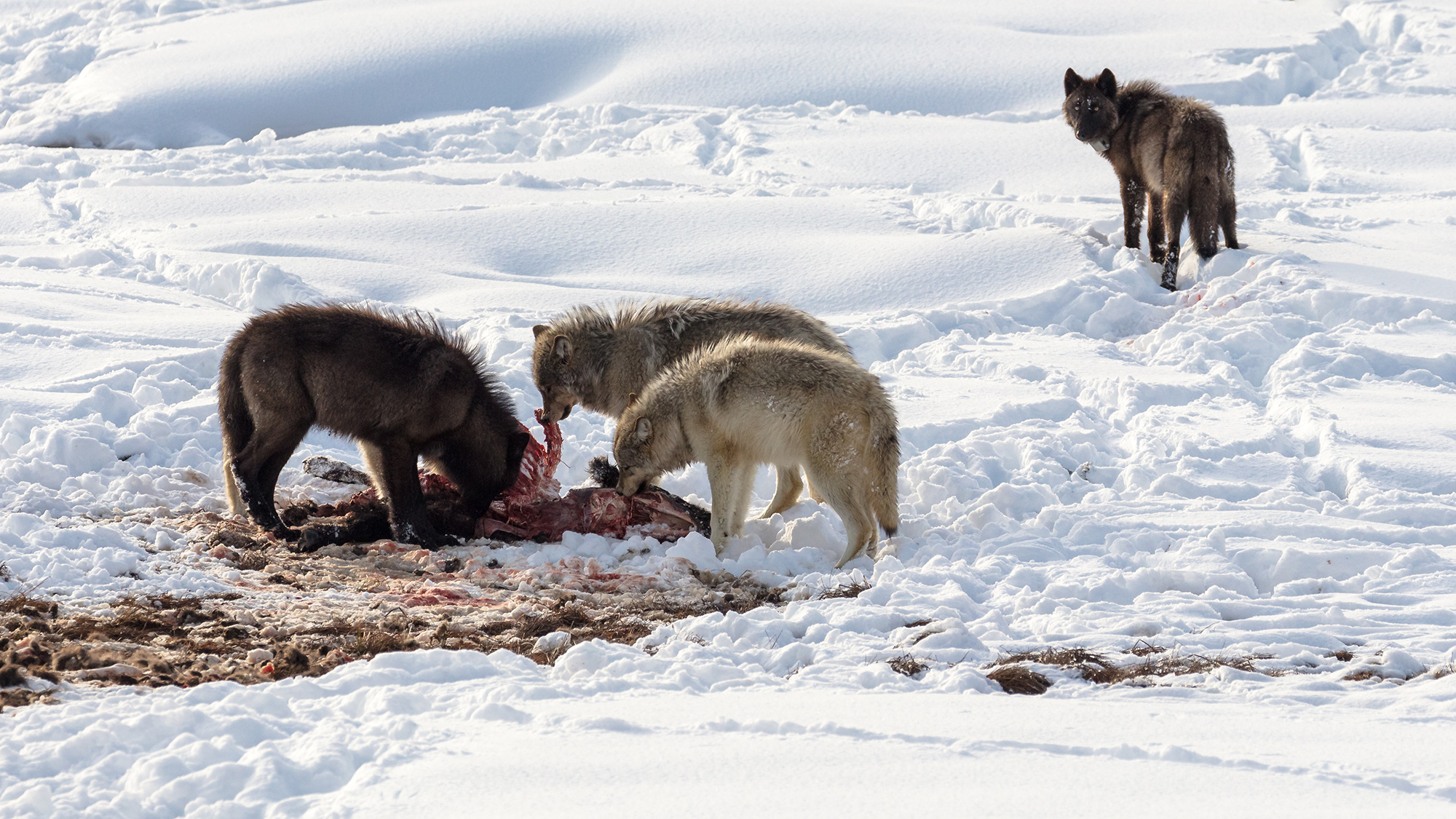THEY WERE UNMISTAKABLE as they moved through the brush. Where there had been nothing moments before, the backs of five wolves now bobbed in silent procession through a thick patch of red willows. I snapped to attention and quietly tipped my tripod-mounted rifle forward. I had to pick one.
In a matter of seconds, they arrived at the bait site and began milling around. I scanned the pack and decided to shoot one of the two pale wolves, both of which stood out from the typical gray of the others. The bait was partially obscured, sitting on a small beaver pond in the center of a large powerline cut. The wolves moved in and out of sight. I needed my wolf to stop in the open, but I only needed a second. I knew chances at wolves are usually fleeting, and every precious second that ticked by was one closer to a sudden departure. Those seconds felt like minutes. Then things began to unravel.
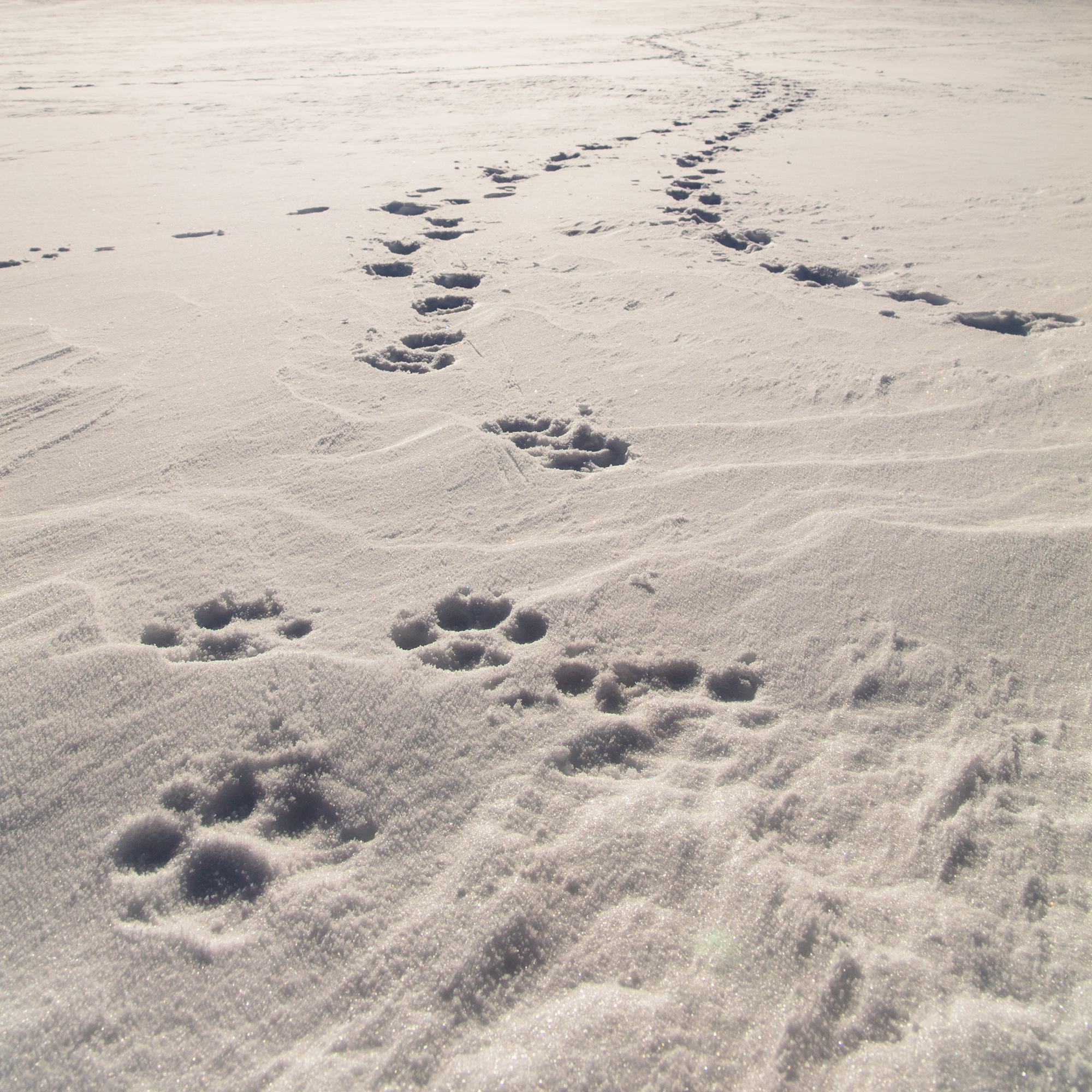
I tried not to let my vision burrow into only the one wolf I wanted. I watched the rest of the pack in my periphery as I waited for a clear shot. Maybe the old box blind made a noise as I shifted my weight; I don’t remember. But when that pale wolf looked right at me, I knew my opportunity was about to disappear. Just as quickly, the wolf turned into a tawny-white flash, running through the brush in the direction the pack had come from. As the pale wolf passed the others, they turned to follow. It played out in my mind instantly. In fewer than five seconds they’d be gone—a whole pack of wolves in front of me, about to disappear without me ever firing a shot.
Wolves Are Just Wolves
Wolves have stoked the fire of human emotion for centuries. They have been characterized as monsters by some, and viewed as the sacred, natural form of man’s best friend by others. In many ways, the idea of the wolf is more influential than the wolf itself. The mere mention of wolves can conjure strong, spirited feelings—even for many who have never actually seen one in the wild.
The idea of hunting wolves is extremely contentious in the Lower 48 and abroad, and even within the hunting community. This is despite the fact that relatively few hunters know what it’s like to hunt wolves. You can see this polarization in the wildly varied regulations around wolf hunting in North America, which are deeply influenced by public opinion.
- Alaska: Hunters can take up to 10 wolves per day in most areas and no there’s no limit when hunting under a trapping license
- Alberta: No daily or seasonal bag limit for wolves
- Minnesota: After Alaska, this Minnesota has the most wolves of any state. But Minnesota has no wolf season because wolves are federally protected here
- Wisconsin: Licensed hunters harvested 216 wolves during a three-day hunt in February 2021. Wolves regained federal protection here one year later
- Montana: Archery, rifle, and trapping opportunities with a statewide quota of 456 for 2022
- Idaho: Wolf hunting and trapping open, no daily or season bag limits
- Colorado: Planning to reintroduce 30 to 50 gray wolves from northern Rockies states over three to five years beginning in 2024. No future sport hunting is included in the plan
I think that often, this spiritual idea of the wolf is a disservice to real wolves. The real wolf is often lost in the mix of rhetoric, propaganda, and news coverage. Wolves are not evil or good, vile or noble—they’re just wolves. They do what nature built them to do. Those who have a real connection to wolves on the landscape are almost always pitted against those who feel that they should be universally protected. In areas where natural populations of wolves have never been in danger of extirpation, those who trap and hunt them recognize the wolf’s value in the ecosystem, but also acknowledge that management is important to maintain balance.
Frank Glaser, the subject of former OL contributor Jim Rearden’s book Alaska’s Wolf Man, is one of Alaska’s most famous wolfers. Rearden describes Glaser’s observations of wildlife during his decades in Alaska’s wilderness. He talks about seesaw-like swings between abundant moose, sheep, and caribou populations, and then their scarcity when wolf numbers boom. Glaser is portrayed as admirably as any hunter or trapper could hope to be regarding wolves:
“In spite of his lifetime contest with wolves, he had the sort of love and respect for the creatures that develop between strong antagonists. He controlled wolves where they were out of hand but the idea of an Alaska without wolves was as abhorrent to Frank Glaser as to anyone in the land today.”
A Worthy Prey
From my perspective as a relatively well-traveled Alaskan hunter, the notion of specifically hunting wolves is an odd one. It’s not that I think there’s something wrong with hunting wolves; rather, it’s strange because targeting wolves with any sort of traditional hunting method is usually pointless here in Alaska. Your chances of success are almost zero. Hunters do kill a number of wolves in Alaska each hunting season, but it’s almost always because of an incidental encounter—not a targeted effort. Trapping is more effective for wolves, but even that is usually an exercise in frustration and missed opportunities.
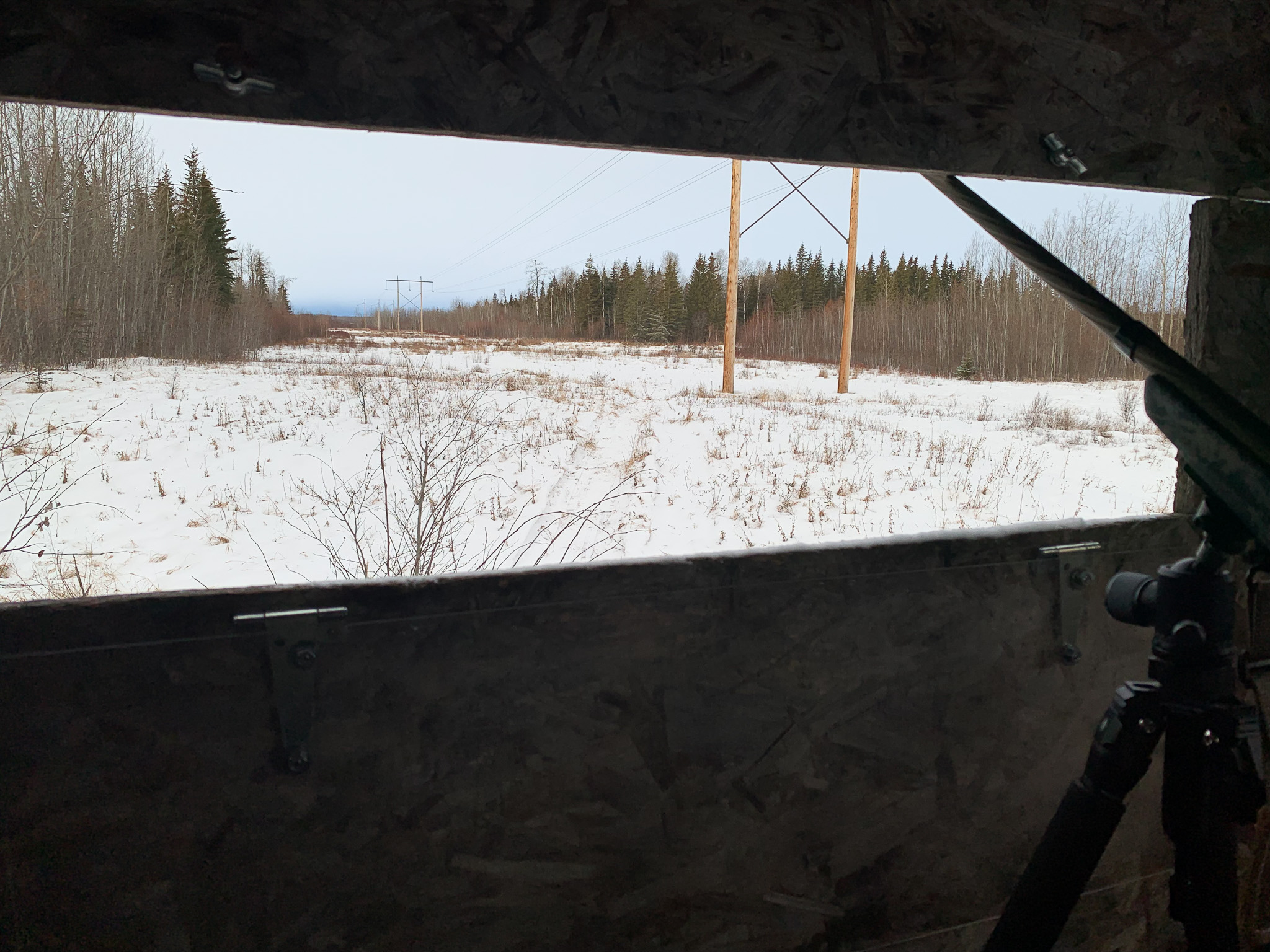
Wolves carry an aura of mystery because they’re so elusive, and many hunters are momentarily stunned with disbelief. Once, I missed a big wolf with a recurve bow from about 15 yards. I’m convinced that I missed because I couldn’t believe it was still standing there. My dad and I were driving along a remote road when we saw the wolf in the middle of the road ahead of us. We slowed down and the wolf walked a few yards into the trees. I got out, grabbed my bow, and stepped into the trees. I don’t remember even aiming due to the shock of the opportunity. Every time I see a wolf, my brain tells me for a split second that it can’t actually be a wolf.
Hunting wolves anywhere brings significant challenges. They are supremely intelligent and operate with an awareness that most game doesn’t possess. In my experience with trapping wolves (which, by Alaskan standards, is limited), I’ve seen many sets of wolf tracks pause and avoid unnatural features like marten sets, even if there’s bait. When I’ve been successful in catching a wolf in an area that a pack frequents, I’ve noticed that the pack will almost always give that spot a wide berth—even years later. Wolves are keen and spooky, and they have an uncanny ability to recognize and remember danger.
In spite of his lifetime contest with wolves, Glaser had the sort of love and respect for the creatures that develop between strong antagonists. He controlled wolves where they were out of hand but the idea of an Alaska without wolves was as abhorrent to Frank Glaser as to anyone in the land today.
—Jim Rearden
In most of Alaska, the country is so big and wolves cover so much ground that seeing one is almost complete luck. Even hunting wolves with bait is a losing proposition in most of Alaska. Wolves can be called in with some skill, patience, and luck, but doing your calling within earshot of a receptive wolf is a challenge in itself. Legendary hunters like Glaser, who shot many wolves on foot, did so only by spending years in the wilderness pursuing them.
The wolf is nothing if not worthy prey for a hunter. In areas with well established, self-sustaining populations, regular hunting poses no threat to their existence. Even in areas of Alaska with active predator control programs, where airplanes and helicopters are used, wolf suppression is only partial and fleeting. The State of Alaska recently concluded a seven-year wolf control program in the Fortymile country to bolster moose and the Fortymile caribou herd. Between government and private operators, several hundred wolves were killed each spring, which gave moose and caribou calves a brief respite. When the program concluded, however, surveys estimated that there were just as many wolves as when they started, according to Fairbanks area ADF&G biologist Tony Hollis.
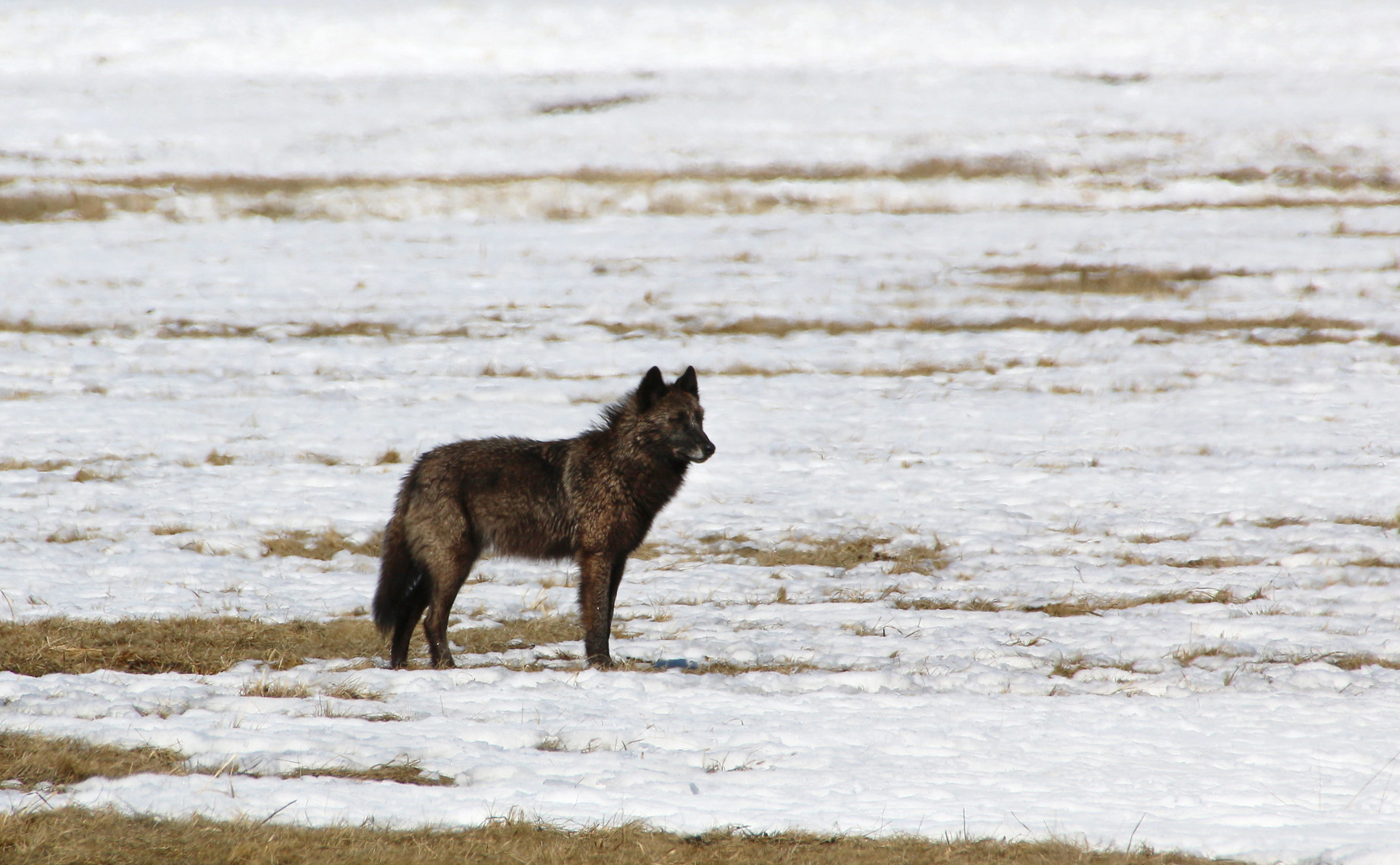
You might get lucky and spot a wolf on your first day hunting, or spend years trying to target them without a single opportunity.
Seeing a wolf and killing one are two entirely different things. If you get a shot, the opportunity will likely be fleeting. In addition to their wary nature, a wolf is a relatively small, constantly moving target. We think of the canines as big animals, but you’re aiming for a vital area smaller than a deer’s—outfitters I’ve talked to have told me that half the hunters who get shots at wolves miss. Wolves are generally tougher than many other game animals. They won’t easily succumb to marginal shot placement.
The Alberta Wolf Hunting Exception
The first time I heard about Alberta’s wolfing methods was when my dad and uncle hunted whitetails in northern Alberta 15 years ago. My uncle is a seasoned trapper and explained with awe that their outfitter claimed to snare wolves at the same bait sites every year. It can be near impossible to get a wolf to go within a hundred yards of a man-made bait site in many parts of Alaska. Maybe something was different about wolves in Alberta? I’d have to wait a long time to find out.
My first trip to Alberta was for a whitetail hunt in November 2016 in the Peace River country. That hunt provided valuable insight on how thick wolves are in the province. Tracks were everywhere. Every trail and cut line had wolf tracks, and we even had a wolf come running up to us in the thick brush—maybe thinking we were a moose walking along through the muskeg. The mix of bush and agricultural land was different from much of Alaska, and the woods seemed full of game.
Still, I remained skeptical when I first heard of hunters using bait to hunt wolves in the province. I was used to getting one chance to trap a wolf or two when the pack crossed my trapline—which happened once every six or eight weeks. How the hell could you ever manage to be sitting over the bait site when a pack actually showed up? Surely wolf hunts were just a money-making ploy for outfitters in the offseason to bamboozle unwitting American hunters who were all too happy to fork over cash to sit and wait for a critter that was never going to appear.
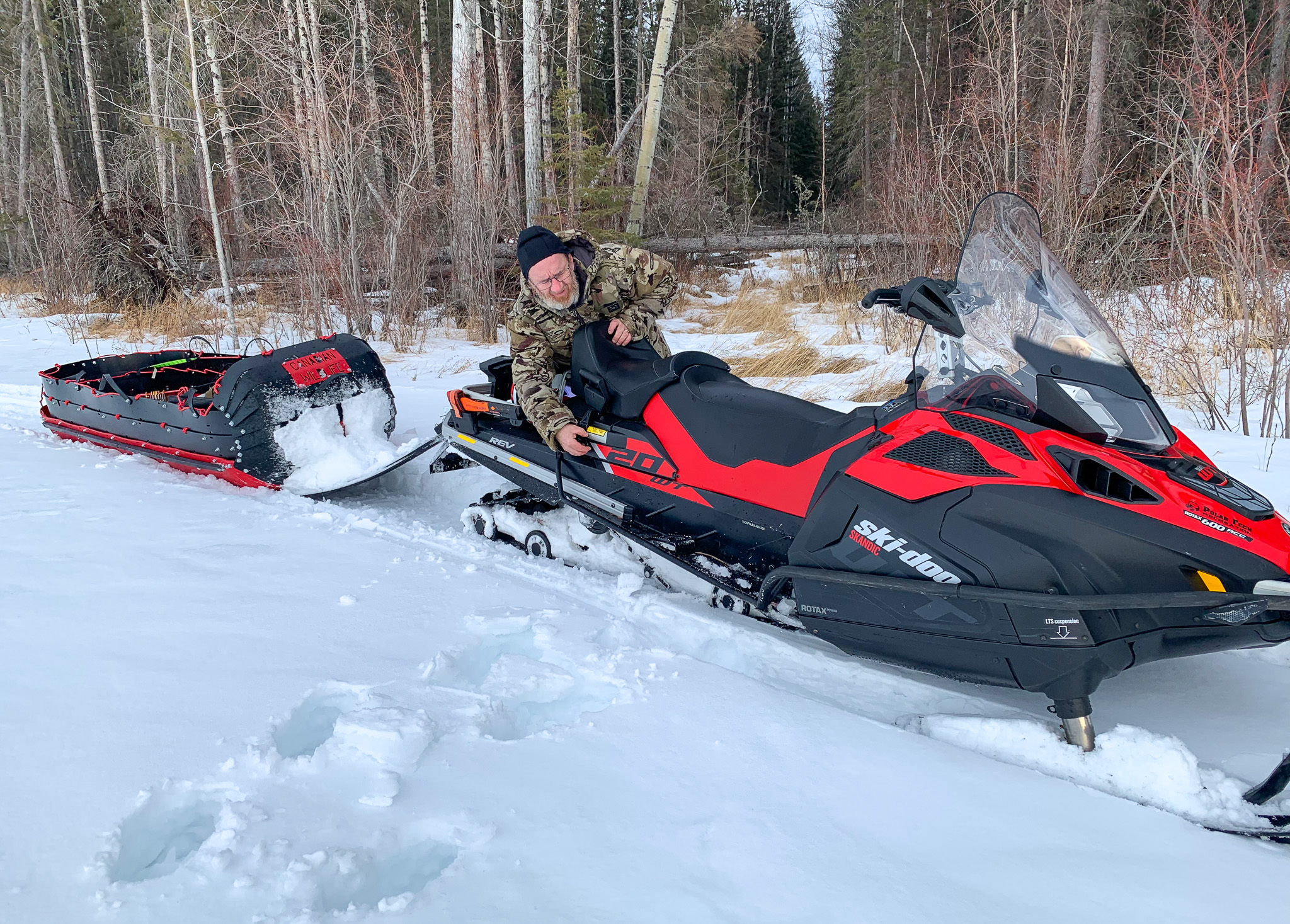
I’ve spent some time thinking about what exactly is different about Alberta, and why hunting wolves there might not be a waste of time. Curiosity gnawed at me. The area where I’d hunted deer had plentiful whitetails, mule deer, moose, and elk—all prime food for wolves. It also had lots of agricultural land that butted against uncut bush country. Maybe these wolves didn’t have to roam as far and were more accustomed to human presence on the landscape. Their population density had to be higher than in my home state.
My curiosity about hunting wolves in Alberta became an opportunity to experience it firsthand when I was invited to hunt with BlueSky Outfitting in the small town of McClennan—about an hour drive from where I’d shot my first whitetail buck in northern Alberta. I approached this hunt with cautious optimism. I’d seen that it could be done, but I was under no illusions about the reality of wolf hunting. At our informal camp meet-and-greet, our outfitter Kevin McNeil gave us some gut-checking instruction:
“If you have wolves come in, don’t screw around,” he said. “Pick one and shoot it, or you’re likely to end up with nothing.”
That checks out, I thought.
A Stroke of Luck
The unnerving and unmistakable howls of a pack of wolves cut through the star-lit morning as our boots crunched through the crust of the snowmachine trail. My guide, Alex, was showing me to my blind on the first day of the hunt, and I froze. The wolves were close—less than a mile away. The howling told me I had a realistic chance of seeing a wolf that day. After settling into the seasoned plywood deer blind, I stuck my head out the window and cut loose with a single wolf howl. I heard nothing in return.
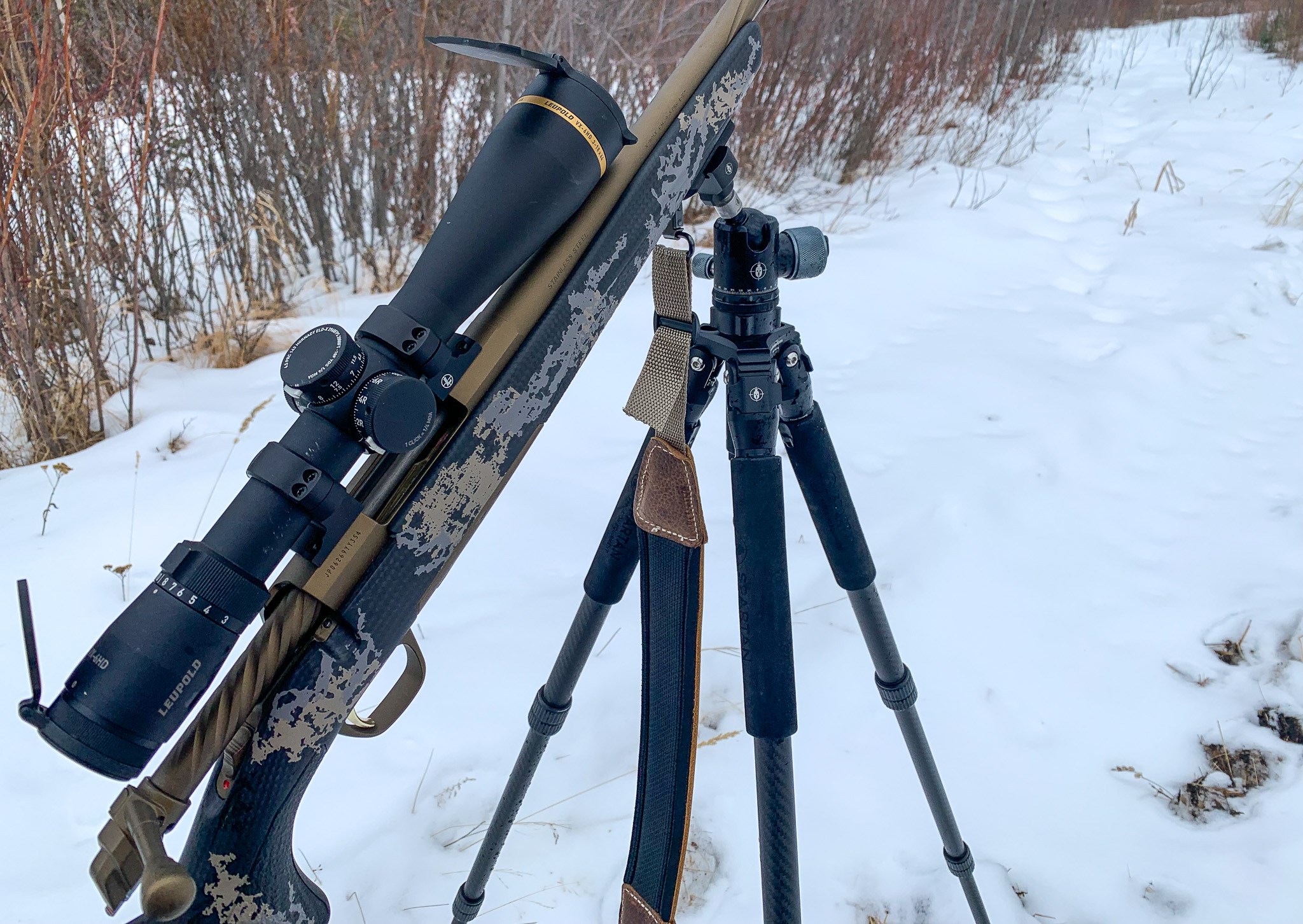
As day broke, ravens and magpies descended from their roosts to pick at the bait pile that had been freshened the previous night. A mix of roadkill and butcher-shop scraps frozen into the ice would keep both wolves and noisy, predator-attracting ravens busy. I’m accustomed to long sits at bear baits, but those hunts are almost always in the evening when the woods are settling down—not waking up. I noticed that the bait rested in a depression on the ice, and that the beaver pond was surrounded by short brush. The brush slightly obscured the bait, but I could see ravens when they landed beside it. The extra cover might make it easier to stay unnoticed by the wolves’ sharp eyes. In all my years of bear baiting, the one wolf I’d seen come to the bait was nervous, watchful, and constantly moving.
Hunting over bait sounds like the most anticlimactic and effort-free method of hunting imaginable, but doing it effectively takes real effort. You’ve got to maintain a balance of readiness, stealth, and patience. A wolf could show up at any moment—or not at all. Take a nap or peel the zipper on your lunch box at the wrong time, and your one opportunity could evaporate before your eyes. Hunting baits for wolves in Alberta often involves sitting all day in subzero weather. And without moving, it’s nearly impossible to stay warm.
Hits and Misses
The instant the wolf’s gaze locked on my blind, I knew time was almost up. I didn’t bother watching the wolf as it ran for the safety of the timber. Instead, I panned for any other wolf that was standing still. It was now or never. At the right-hand edge of the clearing, a single wolf hadn’t realized that the gig was up, and as soon as my crosshairs swept to his midsection, I pulled the trigger. All hell broke loose.
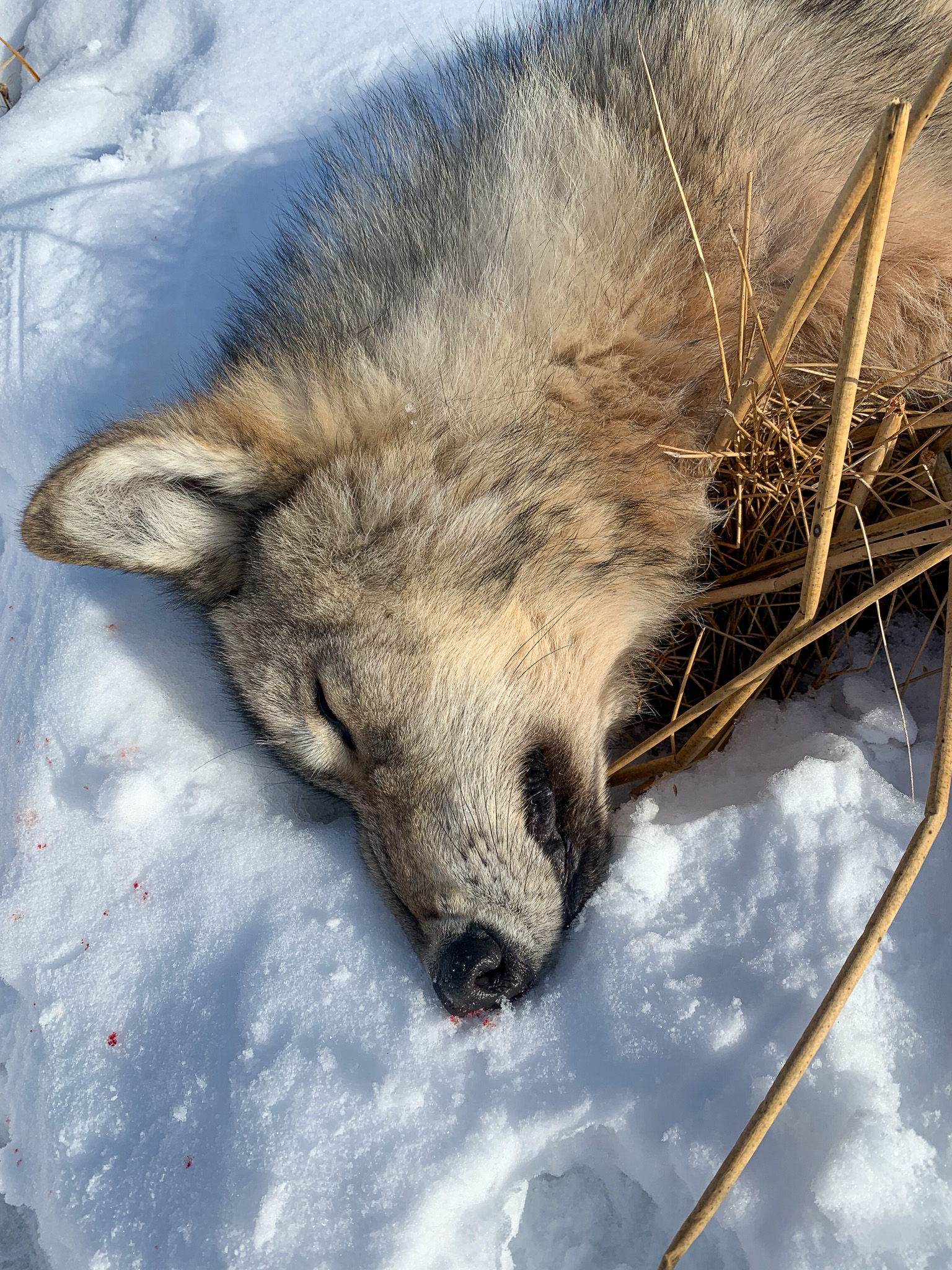
I was always riveted by Glaser’s tales of shooting multiple wolves in one encounter and if anything was clear from those tales, it was that I’d have to shoot fast. When the first shot cracked through the still morning air, I saw the wolf hunch—a reaction to the 143-grain ELD-X. Immediately I panned left, and saw two wolves now bounding through the snow—including the pale one. They had reversed direction at the shot and, at 175 yards, were now running from left to right. I just had time to think, I should hold right in front of his nose.
Bang! The pale wolf didn’t react to the shot, and I picked up the second in my scope as I chambered another round. Trust the hold.
Bang! That wolf didn’t fold either. In a matter of five seconds, all was quiet.
I scrambled out of the blind and walked over to make sure there weren’t any wolves that needed a second shot. I didn’t see the first wolf, which had run a short distance and died in a small depression, and the two sets of tracks from the others didn’t indicate any hits. I’d managed to miss both of them. I led them too much and should have held dead-nuts on the loping wolves. I sent a text to the outfitter and turned to walk back toward the box to wait. With the pack scattered, the wolves began howling all around me. I answered, hoping to draw one of them back.
In a move that I would have predicted had I been thinking clearly, the two wolves I’d missed crossed the 75-yard-wide powerline cut behind me to rejoin their pack. I was back in my blind and had been sitting for 10 minutes when I looked over my shoulder and saw the pale wolf stepping into the cut. I spun around, dropped to my knees, and opened the thin plexiglass window. It was a long shot, but I didn’t have time to use my rangefinder. I grabbed 300 yards of elevation on my CDS dial and let out a howl. The wolf stopped just short of the timber. I fired, sending a plume of snow into the air and the wolf running to safety.
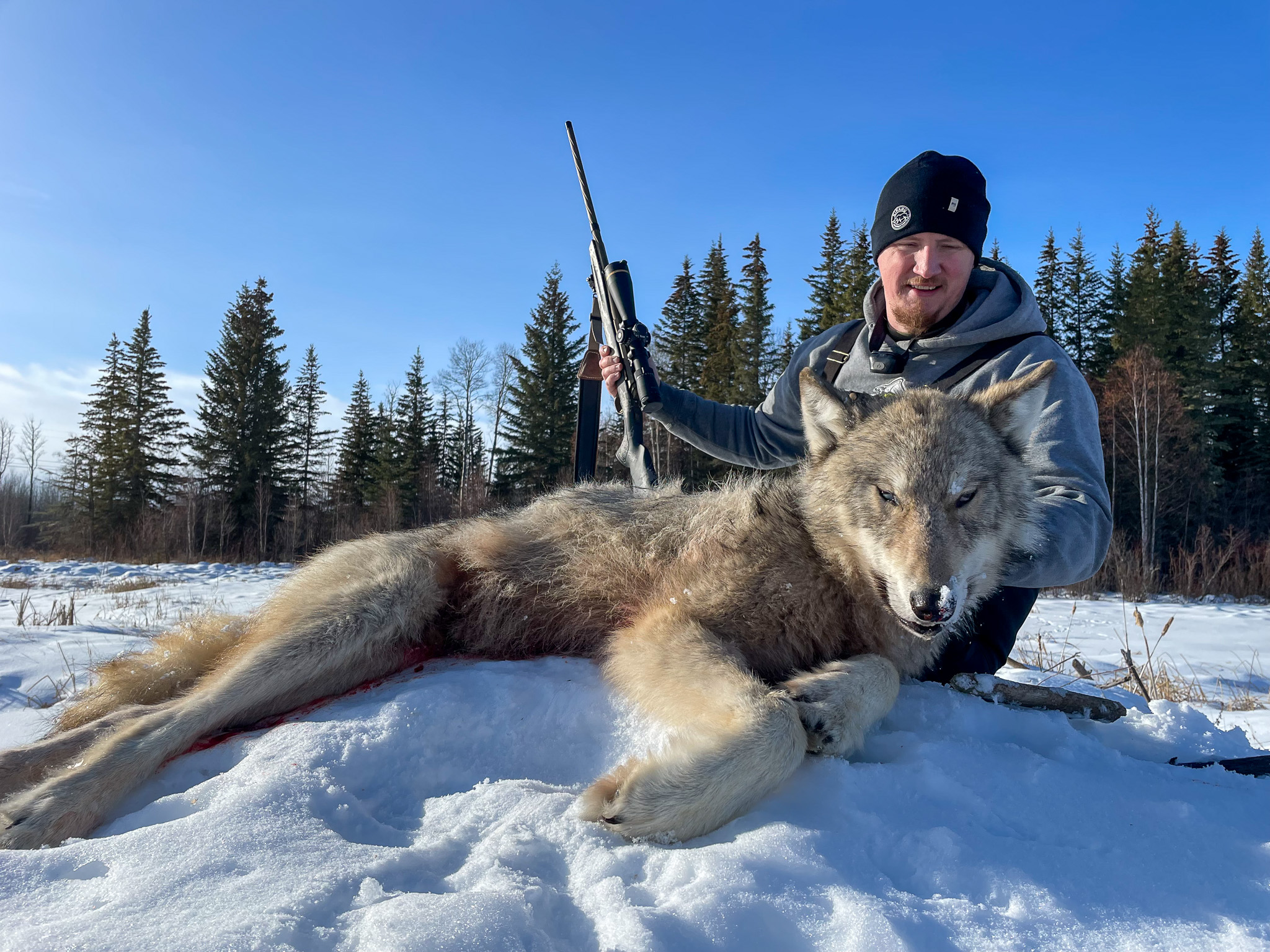
If I wasn’t a knucklehead incapable of learning from my mistakes, I would have ranged the spot where the wolf crossed and then I’d have waited for the second wolf. I didn’t. A few minutes later, the second wolf trotted into the clearing. I’d left the window open, but had to whirl around again. Like an embarrassing playback, I hastily twisted the dial to 300 yards. The wolf stopped, and I squeezed one off. The wolf dropped, then flipped over and reversed direction. I shot again. I could see blood in the snow, and fired one last shot as it escaped into the trees.
Soon enough Kevin and Alex arrived by snowmachine. We carefully examined the tracks near the bait site and found the first wolf I had killed. He was a young male, likely a pup from the previous spring (these youngsters often make up the majority of a pack). He weighed about 80 pounds, which is comparable to most of the young wolves I’ve handled in Alaska. A big one is over 100 pounds, and the biggest I’ve ever seen was 126 pounds. This one had the characteristically pungent odor of a wolf and—always the most striking feature when walking up to a wolf—enormous paws.
We collected the first wolf then optimistically went to search for the second one I’d hit. Even considering the snow, the blood trail was dramatic, but with every step I became more convinced that I’d hit him low. After the shooting, I had ranged the distance at 395 yards, not 300. Two miles down the trail, it was evident that we weren’t going to catch up to the wolf and he’d quit bleeding.
If there’s anything that keeps me awake at night more than missing an animal or squandering an opportunity, it’s wounding and losing one. I’d managed all three in one go. Don’t get me wrong: I was ecstatic about even one wolf—and after the first shot, anything else was just a bonus. I’ll admit that I’m less shrewd about slinging bullets at wolves and coyotes than I am with moose, caribou, sheep, or deer. But still, I hate wounding any animal.
A Waiting Game
If I’d been lucky on the first day, the rest of the hunt was a more realistic wolf hunt. The four hunters in our party would be dropped off at our respective blinds before daylight broke and picked up as darkness fell. One of the other hunters saw a wolf after shooting light the first night—but that was it. We sat a collective 240 hours. At the end of it all, I was the only one who had gotten a real opportunity.
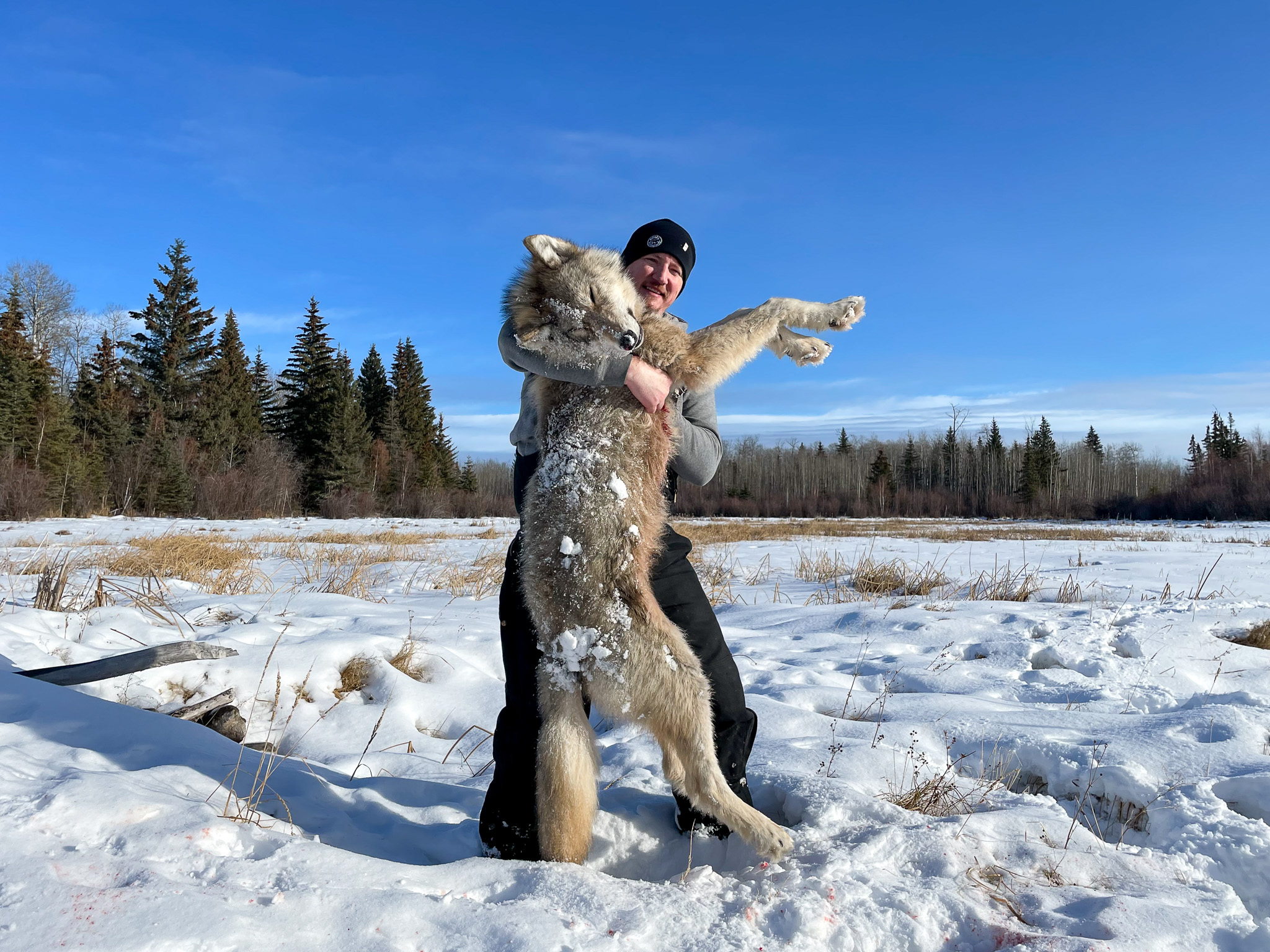
But we knew that wolves were all around us. The fresh skiffs of snow revealed wolf tracks everywhere. We were hunting just minutes from town, and every road, cut line, and deer trail was peppered with wolf tracks. While driving, we spotted wolves cruising open fields like coyotes—something you’ll almost never see near my home in Fairbanks, Alaska.
Wolves are so steeped in controversy and mystery that the challenge of hunting them is often lost in either contempt for their existence or a desire to protect them at all costs. But when you do hunt them, you’ll find wolves to be one of the most challenging and elusive animals in North America. You might get lucky like I did on that first day. Hunt them long enough and each time you’re successful, you’ll still stand over the wolf, looking at it in disbelief.
Read more OL+ stories.
